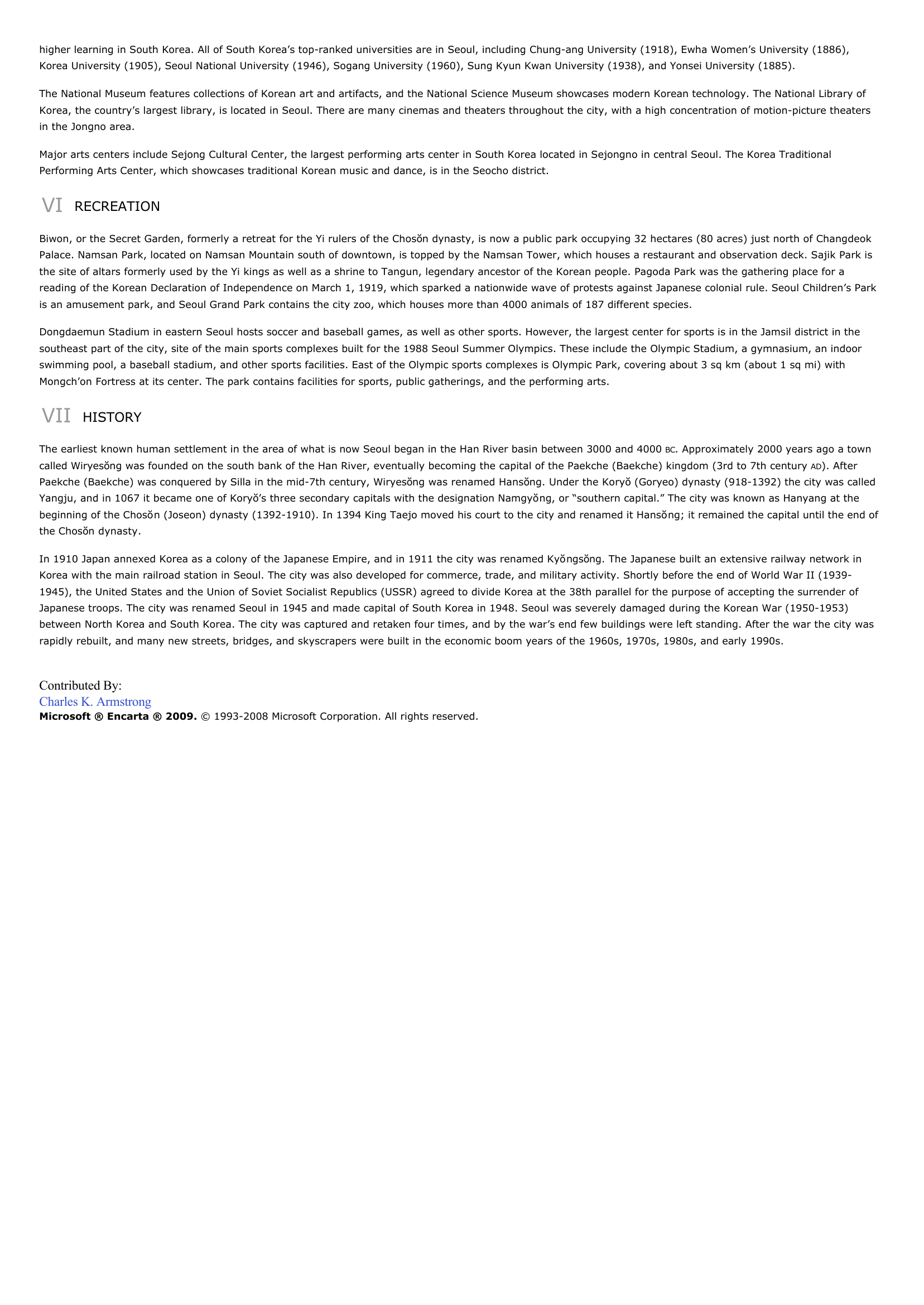Seoul - geography.
Publié le 04/05/2013

Extrait du document
«
higher learning in South Korea.
All of South Korea’s top-ranked universities are in Seoul, including Chung-ang University (1918), Ewha Women’s University (1886),Korea University (1905), Seoul National University (1946), Sogang University (1960), Sung Kyun Kwan University (1938), and Yonsei University (1885).
The National Museum features collections of Korean art and artifacts, and the National Science Museum showcases modern Korean technology.
The National Library ofKorea, the country’s largest library, is located in Seoul.
There are many cinemas and theaters throughout the city, with a high concentration of motion-picture theatersin the Jongno area.
Major arts centers include Sejong Cultural Center, the largest performing arts center in South Korea located in Sejongno in central Seoul.
The Korea TraditionalPerforming Arts Center, which showcases traditional Korean music and dance, is in the Seocho district.
VI RECREATION
Biwon, or the Secret Garden, formerly a retreat for the Yi rulers of the Chosŏn dynasty, is now a public park occupying 32 hectares (80 acres) just north of ChangdeokPalace.
Namsan Park, located on Namsan Mountain south of downtown, is topped by the Namsan Tower, which houses a restaurant and observation deck.
Sajik Park isthe site of altars formerly used by the Yi kings as well as a shrine to Tangun, legendary ancestor of the Korean people.
Pagoda Park was the gathering place for areading of the Korean Declaration of Independence on March 1, 1919, which sparked a nationwide wave of protests against Japanese colonial rule.
Seoul Children’s Parkis an amusement park, and Seoul Grand Park contains the city zoo, which houses more than 4000 animals of 187 different species.
Dongdaemun Stadium in eastern Seoul hosts soccer and baseball games, as well as other sports.
However, the largest center for sports is in the Jamsil district in thesoutheast part of the city, site of the main sports complexes built for the 1988 Seoul Summer Olympics.
These include the Olympic Stadium, a gymnasium, an indoorswimming pool, a baseball stadium, and other sports facilities.
East of the Olympic sports complexes is Olympic Park, covering about 3 sq km (about 1 sq mi) withMongch’on Fortress at its center.
The park contains facilities for sports, public gatherings, and the performing arts.
VII HISTORY
The earliest known human settlement in the area of what is now Seoul began in the Han River basin between 3000 and 4000 BC.
Approximately 2000 years ago a town called Wiryes ŏng was founded on the south bank of the Han River, eventually becoming the capital of the Paekche (Baekche) kingdom (3rd to 7th century AD).
After Paekche (Baekche) was conquered by Silla in the mid-7th century, Wiryes ŏng was renamed Hans ŏng.
Under the Kory ŏ (Goryeo) dynasty (918-1392) the city was calledYangju, and in 1067 it became one of Kory ŏ’s three secondary capitals with the designation Namgy ŏng, or “southern capital.” The city was known as Hanyang at thebeginning of the Chos ŏn (Joseon) dynasty (1392-1910).
In 1394 King Taejo moved his court to the city and renamed it Hans ŏng; it remained the capital until the end ofthe Chos ŏn dynasty.
In 1910 Japan annexed Korea as a colony of the Japanese Empire, and in 1911 the city was renamed Ky ŏngs ŏng.
The Japanese built an extensive railway network inKorea with the main railroad station in Seoul.
The city was also developed for commerce, trade, and military activity.
Shortly before the end of World War II (1939-1945), the United States and the Union of Soviet Socialist Republics (USSR) agreed to divide Korea at the 38th parallel for the purpose of accepting the surrender ofJapanese troops.
The city was renamed Seoul in 1945 and made capital of South Korea in 1948.
Seoul was severely damaged during the Korean War (1950-1953)between North Korea and South Korea.
The city was captured and retaken four times, and by the war’s end few buildings were left standing.
After the war the city wasrapidly rebuilt, and many new streets, bridges, and skyscrapers were built in the economic boom years of the 1960s, 1970s, 1980s, and early 1990s.
Contributed By:Charles K.
ArmstrongMicrosoft ® Encarta ® 2009. © 1993-2008 Microsoft Corporation.
All rights reserved..
»
↓↓↓ APERÇU DU DOCUMENT ↓↓↓
Liens utiles
- Seoul - geography.
- Tokyo - geography.
- Toronto - geography.
- Venice (Italy) - geography.
- Vienna - geography.


